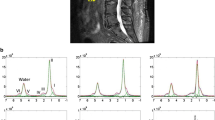Abstract
In order to investigate the relationship between changes in blood circulation and bone mineral density (BMD) loss, the characteristic parameters reflecting the function of tissue oxygen metabolism are obtained by means of blood oxygen level-dependent magnetic resonance imaging (BOLD-MRI), image processing and semi-quantitative analysis. The correlation and variance analysis of the characteristic parameters of different BMD groups are carried out, and the physiological parameters of bone marrow blood perfusion are obtained by dynamic enhanced MRI (DCE-MRI). Multivariate logistic regression analysis is carried out with the physiological parameters of blood oxygen metabolism function and bone marrow blood perfusion as independent variables and BMD as dependent variables. It is found that there are significant differences in oxygen metabolism between individual muscles in different BMD groups and between skeletal muscles of different types of muscle fibers. Age, total volume of bone marrow and oxygen metabolism ability of tibial anterior muscle have significant independent effects on osteoporosis. It shows that the changes of blood circulation in bone marrow and surrounding muscle tissue are indeed one of the causes of osteoporosis.

Similar content being viewed by others
References
Honig, S., Rajapakse, C. S., and Chang, G., Current treatment approaches to osteoporosis-2013. Bull. Hosp. Jt Dis. 71(3):184–188, 2013.
Notarnicola, A., Maccagnano, G., Moretti, L., Tafuri, S., and Moretti, B., Cardiopathy and osteoporosis: The epidemiology in a region of Italy. J. Biol. Regul. Homeost. Agents 31(1):251–255, 2017.
Huang, C., Zhang, G. F., Han, J., Liao, G. J., and Zou, B. G., Mechanism of age-related changes of bone marrow mesenchymal stem cells in senile osteoporosis. J. Biol. Regul. Homeost. Agents 30(2):565–569, 2016.
Zhang, N., Magland, J. F., Rajapakse, C. S., Lam, S. C. B., and Wehrli, F. W., Assessment of trabecular bone yield and post-yield behavior from high-resolution mri-based nonlinear finite element analysis at the distal radius of premenopausal and postmenopausal women susceptible to osteoporosis. Acad. Radiol. 20(12):1584–1591, 2013.
Baum, T., C Karampinos, D., Liebl, H., J Rummeny, E., Waldt, S., and S Bauer, J., High-resolution bone imaging for osteoporosis diagnostics and therapy monitoring using clinical MDCT and MRI. Curr. Med. Chem. 20(38):4844–4852, 2013.
Manenti, G., Capuani, S., Fusco, A., Fanucci, E., Tarantino, U., and Simonetti, G., Osteoporosis detection by 3T diffusion tensor imaging and MRI spectroscopy in women older than 60 years. Aging Clin. Exp. Res. 25(1):31–34, 2013.
Thomassin-Naggara, I., Aubert, E., Rockall, A., Jalaguier-Coudray, A., Rouzier, R., Daraï, E., and Bazot, M., Adnexal masses: Development and preliminary validation of an MR imaging scoring system. Radiology 267(2):432–443, 2013.
Dacosta-Aguayo, R., Grana, M., Iturria-Medina, Y., Fernández-Andújar, M., López-Cancio, E., Caceres, C., and Fores, R., Impairment of functional integration of the default mode network correlates with cognitive outcome at three months after stroke. Hum. Brain Mapp. 36(2):577–590, 2015.
Zhou, X., Hu, X., Zhang, C., Wang, H., Zhu, X., Xu, L., and Yu, Y., Aberrant functional connectivity and structural atrophy in subcortical vascular cognitive impairment: Relationship with cognitive impairments. Front. Aging Neurosci. 8(1):14, 2016.
Zhang, K., Herzog, H., Mauler, J., Filss, C., Okell, T. W., Kops, E. R., … and Coenen, H. H., Comparison of cerebral blood flow acquired by simultaneous [15O] water positron emission tomography and arterial spin labeling magnetic resonance imaging. J. Cereb. Blood Flow Metab. 34(8):1373–1380, 2014.
Kim, S. J., Son, J. P., Ryoo, S., Lee, M. J., Cha, J., Kim, K. H., … and Bang, O. Y., A novel magnetic resonance imaging approach to collateral flow imaging in ischemic stroke. Ann. Neurol. 76(3):356–369, 2014.
Berg, P., Stucht, D., Janiga, G., Beuing, O., Speck, O., and Thévenin, D., Cerebral blood flow in a healthy circle of Willis and two intracranial aneurysms: Computational fluid dynamics versus four-dimensional phase-contrast magnetic resonance imaging. J. Biomech. Eng. 136(4):041003, 2014.
Author information
Authors and Affiliations
Corresponding author
Ethics declarations
Conflict of interest
Author Xiaoming Qiu declares that he has no conflict of interest. Author Yufei Fu declares that he has no conflict of interest. Author Jiao Chen declares that he has no conflict of interest. Author Yu Ye declares that he has no conflict of interest. Author Zhen Wang declares that he has no conflict of interest. Author Xianfang Ming declares that he has no conflict of interest.
Ethical approval
All procedures performed in studies involving human participants were in accordance with the ethical standards of the institutional and/or national research committee and with the 1964 Helsinki declaration and its later amendments or comparable ethical standards.
This article does not contain any studies with animals performed by any of the authors.
Informed consent
Informed consent was obtained from all individual participants included in the study.
Additional information
Publisher’s Note
Springer Nature remains neutral with regard to jurisdictional claims in published maps and institutional affiliations.
This article is part of the Topical Collection on Image & Signal Processing
Rights and permissions
About this article
Cite this article
Qiu, X., Fu, Y., Chen, J. et al. The Correlation between Osteoporosis and Blood Circulation Function Based on Magnetic Resonance Imaging. J Med Syst 43, 91 (2019). https://doi.org/10.1007/s10916-019-1206-8
Received:
Accepted:
Published:
DOI: https://doi.org/10.1007/s10916-019-1206-8




